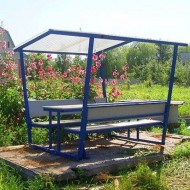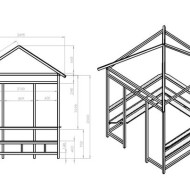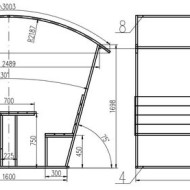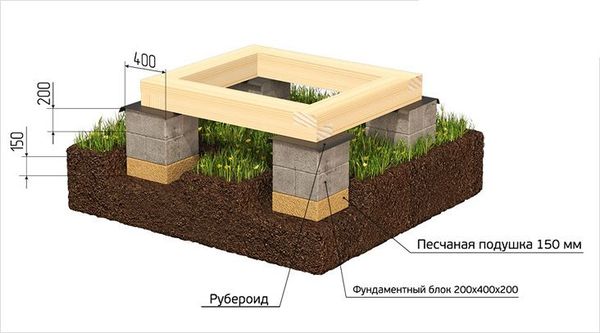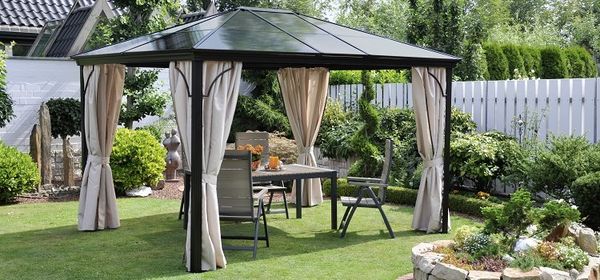Construction for the ages: a gazebo for a garden from a profile pipe
Content
Types of structures
First, let's list the advantages of a metal profile:
- the frame is durable, withstands high loads;
- the structure can be given complex shapes, while it has a low weight;
- construction is cheaper than using wood or natural stone.
Most often, a gazebo in the country is built with their own hands, wanting to get a permanent place to rest. It is used both as a summer kitchen and as a mini-mansion.
Depending on the requirements put forward, the shape of the garden structure is selected. The simplest gazebo is an open frame with a canopy, round, square or hexagonal. It has a floor and decorative walls. This is a summer open type.
Less common is a room of different sizes with full-fledged windows and doors. Here they take refuge from severe weather. You can live here even in winter, if you organize normal heating.
The shape of the roof directly depends on the type of gazebo and the natural features of the area:
- For open summer buildings made of wood or metal, the roof is made curved in the form of an arch using lightweight roofing materials such as polycarbonate. This design is needed to drain water during precipitation.
- For closed rooms, which are built of brick, concrete or stone, a roof is required more solid, one-pitched or several slopes. Cover it with tiles or slate.
- Roofs with a steep slope have an increased "windage"; they are not recommended to be made where strong winds occur.
Video "Construction of a gazebo from a profile pipe"
From this video you will learn how to build a cozy gazebo from a profile pipe with your own hands.
Peculiarities
Here is a set of requirements that should be adhered to when choosing a profile for construction:
- The section can be round, rectangular or square.
- Ordinary steel is suitable, but it is better to take galvanized steel.
- A large section is used for bearing profiles, a small one - as jumpers.
You can fasten iron parts into a single whole by welding or using special fasteners (such as self-tapping screws with thermal washers). Drilling, cutting and bolting is easier for rectangular pipes, and any is suitable for welding, although round ones are more difficult to weld - a certain skill is required.
How to build a simple pavilion
The frame is assembled in a prepared place. Various methods are used for installation:
- Large vertical pipes are concreted into the ground, they will serve as a support for the rest of the structure. This option is suitable for summer gazebos, it does not provide for a solid floor.
- First, a shallow base is prepared on the site in the form of a monolithic slab, columnar or strip foundation. The frame is assembled separately, then, in finished form, it is fixed on the lower harness, laid on the base. The method is used in the construction of open and closed buildings.
In any case, you need to start construction by choosing a suitable place.A secluded area is suitable for a gazebo, preferably on a hill, away from a noisy street, in the shade of trees.
A drawing is selected, and already according to the existing plan, building materials are prepared:
- metal profile;
- roofing material;
- cement mortar or concrete;
- fastening accessories;
- anti-corrosion primer or paint.
To work with profile pipes, you need tools:
- drill for metal with a set of drills;
- grinder or grinder;
- equipment for welding (if necessary);
- self-tapping screws for metal and thermal washers;
- shovel.
Now you can start the construction itself
Base
Most often, a light columnar foundation is built for a homemade gazebo. The site is prepared according to the following step-by-step scheme:
- The top fertile layer is removed to a depth of 20-30 cm to get rid of weeds.
- Marking is applied according to the selected project.
- Pits are dug according to the number of support pillars, the depth is 0.5 m.
- A cushion of sand and gravel (5–10 cm each) is built in the pits.
- Support posts are installed, the bottom is carefully rammed.
- The pit is covered with pieces of brick or stones, and then concreted.
- The height of the racks is leveled.
Supports and floor
When the concrete hardens, proceed to the installation of the lower piping. It is made in the form of a rectangular frame, laid on ready-made supports. The height must be sufficient so that the person does not have difficulty entering. Further, the strapping frame is covered with horizontal logs - the basis for the future floor.
A more budget option allows you to do without flooring at all. In this case, the lower part of the frame is installed directly on the ground, which will continue to function as a floor. However, sometimes, for convenience, the base of the gazebo is still covered with paving slabs or boards.
Then the frame of the future gazebo is erected on the supports. The walls can be laid out in the form of a lattice or made more fancy patterns. They can be left open by erecting railings around the structure at a height of 1 m from the floor. Finally, they often combine different approaches, making one or two walls blank, and the rest open.
What to make a roof out of
If the gazebo is erected from shaped pipes, it is not recommended to make the roof unnecessarily heavy. The more massive the structure, the more powerful foundation it will require, which will significantly increase the cost of construction.
Such characteristics are inherent in many roofing materials:
- Polycarbonate. Monolithic is usually used, it is cheaper. Not suitable for regions with frosty winters - it cracks. It is more often used for collapsible structures. You will need self-tapping screws for fastening.
- Ondulin. Easy to install. Resists temperature extremes well. Long service life. Has thermal insulation properties. Fastened with self-tapping screws or roofing nails.
- Roof tiles. Beautiful appearance, available in different color shades. Suitable for fastening are roofing nails, self-tapping screws with a press washer, staples.
- Tarpaulin. A budget option, suitable for prefabricated summer structures. For installation, ordinary ropes are used.
Decor
Although the metal frame made of pipes has many advantages, its appearance is far from perfect. Experts recommend immediately after the construction of the building to start decorating it.
For vertical and horizontal details, you can start climbing plants - ivy or grapes. The side openings are covered with curtains or other fabrics, which at the same time will serve as a good protection from the wind.
So that you can sit in the gazebo at dusk, lighting is organized in it.
Care rules
The metal profile has a drawback - the metal lends itself to corrosion. To avoid this, metal parts are periodically painted or treated with a special putty. Suitable water-resistant, water-based, sunlight-resistant paints: acrylic, oil, epoxy, etc.
A light and practical gazebo made of shaped pipes will serve the owners for many decades.
It is pleasant to relax here in sunny weather, here you can set a table for the whole family or guests.


